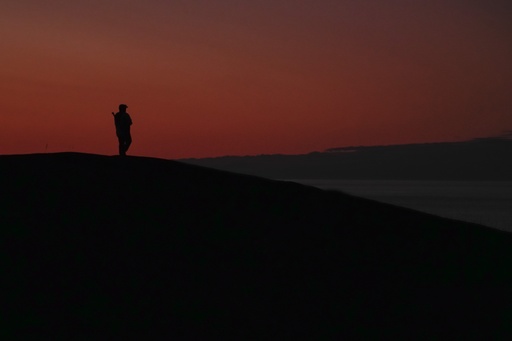
CHURCHILL, Manitoba — As Sgt. Ian Van Nest drives through the town of Churchill, his truck is equipped with a rifle and a barred back seat for potential arrests. He attentively observes a group gathered outside a van, approaches the leader, and inquires, “How are you today?” The leader responds cautiously, “We OK for you here?” Van Nest reassures him that they are in a safe location and advises them to have a bear monitor on standby as they watch a polar bear in the distance. “If that’s you, make sure you have your shotgun ready—slugs and cracker shells or a scare pistol,” he instructs, emphasizing the importance of preparedness in this polar bear season.
Churchill, a small town perched on a land extension into Hudson Bay, relies on safety measures to protect tourists from polar bears, which have increasingly ventured inland in search of food due to the reduction of Arctic sea ice caused by climate change. According to the International Union for the Conservation of Nature, these changes in the bears’ habitat result in them taking greater risks, leading them closer to human populations. Geoff York, from Polar Bears International, notes that while the polar bear population in Western Hudson Bay has dwindled to about 600 bears from 1,200 over the past four decades, this still provides near one bear for each of the town’s residents.
Despite the challenges, the community of Churchill has forged a deep connection with these majestic creatures. In the 1970s, the closure of a military base prompted a drastic population decline, from thousands to around 870. However, the tourist industry focused on polar bear viewing brought new life to the town, with tourists reportedly spending an average of $5,000 per visit and contributing over $7 million annually to the local economy. With a mix of modern restaurants and quaint accommodations, Churchill thrives amid dirt roads without a single stoplight.
Mayor Mike Spence reflects on the coexistence with bears, stating, “It’s their area too. It’s vital for the community to cohabit with bears and enjoy wildlife.” Since a bear incident over a decade ago, where two individuals were mauled before being saved, the town has maintained vigilance. Erin Greene recalls that frightful Halloween night, where a bear attack left her and a 72-year-old man injured. Despite the trauma, Greene found solace in the local wildlife and her rescue dogs, which helped her heal.
While there have been no attacks since that fearful night, the community remains vigilant, especially around Halloween when the bears are hungriest. Volunteers patrol the streets to ensure safety, and any bears that repeatedly enter town may face confinement in polar bear jail—a facility with concrete and steel cells, monitored by conservation officers like Van Nest. Though the jail doesn’t often reach capacity, the sounds of bears can frequently be heard inside.
Churchill’s residents take pride in their association with polar bears, a blend of fear and enjoyment akin to riding a rollercoaster. Merchants like Dave Daley remark on their town’s unique status as the “polar bear capital of the world,” encouraging tourists to engage safely with the majestic creatures. “They’re like the T. rex of the dinosaur era, the Lords of the Arctic, and can be dangerous,” says Daley.
Back in the 1970s, when the military installation was active, bears seemed less curious. Post-closure brought an influx of bears, and the local government established a polar bear alert program to protect the community. Each night, a curfew siren signals at 10 p.m., indicating it’s time to stay indoors. Yet, on this Saturday evening, groups gather on the beach for bonfires, where a guard with a shotgun surveils the area from a distance, ready to deter any bears encroaching on the festivities without harming them.
Spence notes, “It’s just everybody watches out for everybody. It’s engrained in our lives to coexist with the bears.” Georgina Berg, a lifelong resident, recalls her father’s nonchalant attitude towards bears, believing they would be harmless as long as people were not a threat. The change in community behavior surrounding polar bears marks the evolution of their relationship with these animals over the years.
As Van Nest approaches the group of tourists, he reassures them that the bear, only 300 yards away, is merely putting on a display. “This is a great situation to be in,” he comments. “The tourists are safely distanced, and the bear is simply doing its thing without any disturbances.”
